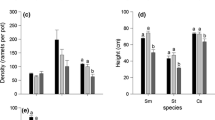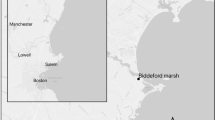Abstract
Background and Aims
Why is the carnivorous pitcher plant, Sarracenia alata Wood, largely absent from eutrophic habitats? Two hypotheses are addressed: (1) Sarracenia alata is competitively excluded by non-carnivorous plants where resource availability is high and (2) S. alata cannot tolerate stressful conditions unrelated to competition in a eutrophic wetland.
Methods
We tested these hypotheses using a reciprocal transplant experiment to compare the performance of Sarracenia alata in eutrophic marsh and oligotrophic bog, crossed with soil source and neighbor removal treatments. Multiple environmental co-variables were also measured to identify factors responsible for transplant performance.
Results
Survivorship was 46.5% greater in the bog than in the marsh, and a significant proportion of the variation was explained by higher redox potential in the bog. Transplants were not negatively impacted by neighbors in either community.
Conclusions
Results lead us to reject the competitive inferiority hypothesis and provide support for a hypothesis of inadequate stress avoidance. We suggest that a lack of tolerance of abiotic stressors, as opposed to competition, be given greater consideration when explaining the distributions of terrestrial hydrophytic carnivorous plants.





Similar content being viewed by others
References
Adamec L (1997) Mineral nutrition of carnivorous plants: a review. Bot Rev 63:273–299
Adamec L (2005) Ecophysiological characterization of carnivorous plant roots: oxygen fluxes, respiration, and water exudation. Biol Plant 49:247–255
Adamec L, Kohout P, Benes K (2006) Root anatomy of three carnivorous plant species. Carniv Plant Newsl 35:19–22
Adlassnig W, Peroutka M, Lambers H, Lichtscheidl IK (2005) The roots of carnivorous plants. Plant Soil 274:127–140
Bertness MD (1991) Zonation of Spartina patens and Spartina alterniflora in New England salt marsh. Ecology 72:138–148
Bott T, Meyer GA, Young EB (2008) Nutrient limitation and morphological plasticity of the carnivorous pitcher plant Sarracenia purpurea in contrasting wetland environments. New Phytol 180:631–641
Brewer JS (1999) Short term effects of fire and competition on growth and plasticity of Sarracenia alata (Sarraceniaceae). Am J Bot 86:1264–1271
Brewer JS (2003a) Why don't carnivorous pitcher plants compete with non-carnivorous plants for nutrients? Ecology 84:451–462
Brewer JS (2003b) Nitrogen addition does not reduce belowground competition in a salt marsh clonal plant community in Mississippi (USA). Plant Ecol 168:93–106
Brewer JS, Grace JB (1990) Plant community structure in an oligohaline tidal marsh. Plant Ecol 90:93–107
Brewer JS, Baker DJ, Nero AS, Patterson AL, Roberts RS, Turner LM (2011) Carnivory in plants as a beneficial trait in wetlands. Aquat Bot 94:62–70
Crawford RMM (1992) Oxygen availability as an ecological limit to plant distribution. In: Begon M, Fitter AH (eds) Advances in ecological research. Academic Press, San Diego 23:93–185
Darwin C (1875) Insectivorous Plants. Murray, London
Ellison AM (2006) Nutrient limitation and stoichiometry of carnivorous plants. Plant Biol 8:740–747
Ellison AM, Gotelli NJ (2002) Nitrogen availability alters the expression of carnivory in the northern pitcher plant, Sarracenia purpurea. Proc Natl Acad Sci U S A 99:4409–4412
Ellison AM, Gotelli NJ (2009) Energetics and the evolution of carnivorous plants-Darwin's 'most wonderful plants in the world. J Exp Bot 60:19–42
Ellison AM, Gotelli NJ, Brewer JS, Cochran-Stafira DL, Kneitel JM, Miller TE, Worley AC, Zamora R (2003) The evolutionary ecology of carnivorous plants. In: Caswell H (ed) Advances in ecological research. Elsevier Science, Philadelphia 33:1–74
Ernst WHO (1990) Ecophysiology of plants in waterlogged and flooded environments. Aquat Bot 38:73–90
Folkerts GW (1982) The Gulf Coast pitcher plant bogs: One of the continent's most unusual assemblages of organisms depends on an increasingly rare combination of saturated soil and frequent fires. Am Sci 70:260–267
Givnish TJ, Burkhardt EL, Happel RE, Weintraub JD (1984) Carnivory in the bromeliad Brocchinia reducta, with a cost/benefit model for the general restriction of carnivorous plants to sunny moist, nutrient-poor habitats. Am Nat 124:479–497
Gotelli NJ, Ellison AM (2002) Nitrogen deposition and extinction risk in the northern pitcher plant, Sarracenia purpurea. Ecology 83:2758–2765
Grime JP (1979) Plant strategies and vegetation strategies. John Wiley and Sons, Chichester
Hackney CT, Avery GB (2015) Tidal wetland community response to varying levels of flooding by saline water. Wetlands 35:227–236
Hilbert KW (2006) Land cover change within the Grand Bay National Estuarine Research Reserve: 1974-2001. J Coast Res 22:1552–1557
Justin SHFW, Armstrong W (1987) The anatomical characteristics of roots and plant response to soil flooding. New Phytol 106:465–495
Lu Q, Bai J, Gao Z, Wang J, Zhao Q (2015) Effects of water level and salinity on total sulfur contents in salt marsh soils of the Yellow River Delta. China, Wetlands
Luo W, Xie Y, Chen X, Li F, Qin X (2010) Competition and facilitation in three marsh plants in response to a water-level gradient. Wetlands 30:525–530
McKee KL, Mendelssohn IA, Hester MW (1988) Reexamination of pore water sulfide concentrations and redox potentials near the aerial roots of Rhizophora mangle and Avicennia germinans. Am J Bot 75:1352–1359
Mitsch WJ, Gosselink JG (2007) Wetlands. John Wiley & Sons, Hoboken
MSCNWR (1996) Mississippi Sandhill Crane National Wildlife Refuge fire management plan. U.S. Fish and Wildlife Service, Gautier
Odum WE, Smith TJ III, Hoover JK, McIvor CC (1984) The ecology of tidal freshwater marshes of the United States East Coast: a community profile. U.S. Fish and Wildlife Service, Washington DC
Outcalt KW, Williams ME, Onokpise O (1999) Restoring Aristida stricta to Pinus palustris ecosystems on the Atlantic Coastal Plain, U.S.A. Restor Ecol 7:262–270
Pennings SC, Grant M-B, Bertness MD (2004) Plant zonation in low-latitude salt marshes: disentangling the roles of flooding, salinity and competition. J Ecol 93:159–167
Seago, J.L., Jr. and five others, 2005. A re-examination of the root cortex in wetland flowering plants with respect to aerenchyma. Ann Bot 96, 565-579.
Thorén LM, Karlsson PS (1998) Effects of supplementary feeding on growth and reproduction of three carnivorous plant species in a subarctic environment. J Ecol 86:501–510
Twolan-Strutt L, Paul KA (1996) Above- and belowground competition intensity in two contrasting wetland plant communities. Ecology 77:259–270
Wilson SC (1985) The growth of Drosera intermedia in nutrient-rich habitats: the role of insectivory and interspecific competition. Can J Bot 63:2468–2469
Zamora R, Gómez JM, Hódar JA (1998) Fitness responses of a carnivorous plant in contrasting ecological scenarios. Ecology 79:1630–1644
Acknowledgments
We would like to thank the staff at both Grand Bay National Estuarine Research Reserve and Sandhill Crane National Wildlife Refuge for providing logistical support in this project. We would also like to thank Dr. Jason Hoeksema, Dr. Megan Rúa, Dr. Bridget Piculell and Ann Rasmussen for their assistance in the field and for providing helpful suggestions in the initial prepping stages of the manuscript. We must also thank the three anonymous reviewers that provided constructive comments and suggestions that helped greatly enhance the quality of the manuscript. This project was funded by grants from the Society of Wetland Scientists Student Research Program, Sigma Xi Grants-In-Aid of Research Program, and the University of Mississippi Graduate Student Research Program.
Author information
Authors and Affiliations
Corresponding author
Additional information
Responsible Editor: Hans Lambers.
Rights and permissions
About this article
Cite this article
Abbott, M.J., Brewer, J.S. Competition does not explain the absence of a carnivorous pitcher plant from a nutrient-rich marsh. Plant Soil 409, 495–504 (2016). https://doi.org/10.1007/s11104-016-3011-1
Received:
Accepted:
Published:
Issue Date:
DOI: https://doi.org/10.1007/s11104-016-3011-1




